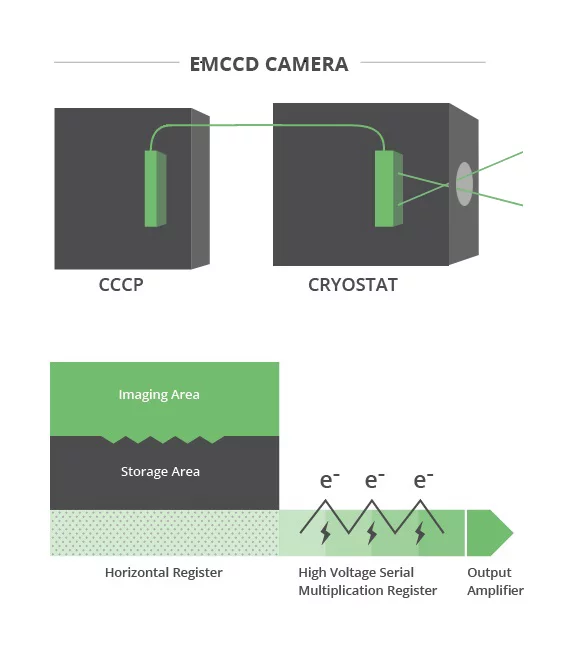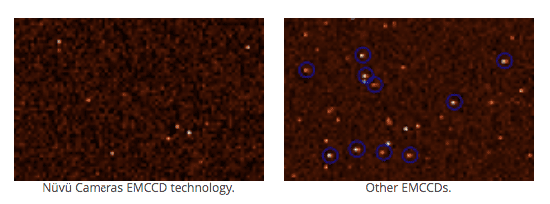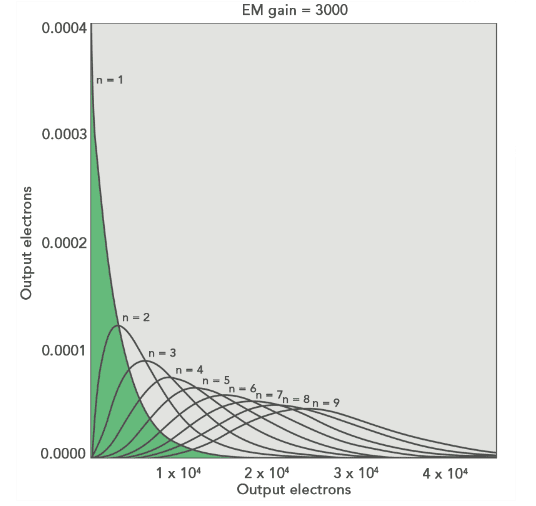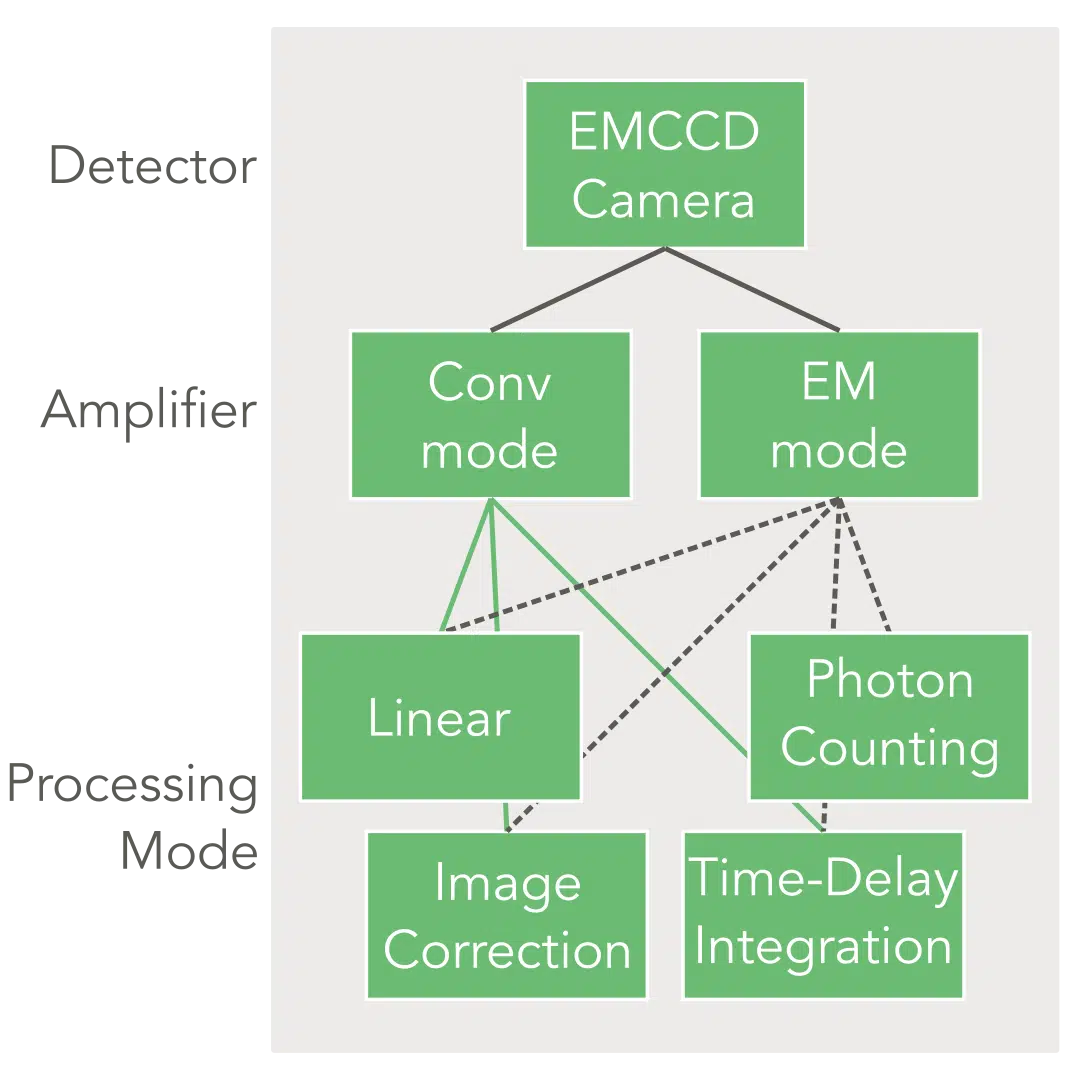Products
Your all-inclusive solution
All Products
Download our catalog
Get our Catalog
Applications
Low light imaging takes place in various fields, from the infinitely small to the infinitely large. It can occur while tracking down the molecular dynamics of brain synapses with fluorescent markers or studying the atmosphere of a faraway extrasolar planet through spectroscopy. However, in all circumstances, when photons are scarce, the signal reaching the imaging device may be weak enough to blend with the background noise. A strategy to recover the photon signal is thus much needed.
Electron-multiplying CCD (EMCCD) technology, sometimes referred to as low light level CCD (L3CCD), is designed to beat down the intrinsic electronic noise of the readout process, which is comparable to a signal of a few photons per exposure. In this way, EMCCD cameras address the challenges of most low light imaging. They also support faster frame acquisition rates than their CCD counterparts, making them highly suitable for live imaging. Better still, EMCCD cameras can offer ultimate sensitivity for the observation of the darkest scenes by becoming wide-field real-time photon counting imaging devices.
This series of pages has the goal to inform you about the various specificities of EMCCDs; from noise sources & operation modes to advanced photon counting operation.

A relative of the charge-coupled device (CCD) technology, the EMCCD is a frame-transfer CCD to which is added a special output register. It operates by first transforming incident photons into photoelectrons in the detector’s light-sensitive region—the imaging region—located within the camera’s cooled enclosure. The sensor’s silicon body is meticulously organized in a matrix of potential wells, or pixels, that trap photoelectrons as they are created through the photoelectric effect during exposure. Following the collection of these negative charges, the application of a series of voltages across the sensor forces the transfer of all electrons from the imaging to the storage region of the detector. Doing so ensures the processing of the acquired image while performing a new acquisition.
In the storage region, the electrons at the detector’s bottommost row travel pixel by pixel into the multiplication register, which comprises several hundred electrodes. When a photoelectron encounters an electrode, there is a 1–2% probability that it will generate a secondary electron by impact ionization, a type of avalanche effect. As a result, an incoming signal of a few photons can be amplified up to several thousand times. The charges then reach the output amplifier where they are converted into an electric impulse subsequently digitized to form an image.
Compared to other low flux imaging technologies, an EMCCD shows high quantum efficiency (QE) and little dark current, much like traditional CCDs. More, it presents negligible readout noise akin the intensified CCDs (ICCD), thus providing the best sensitivity in poor lighting conditions. For more information about the various low light imaging cameras available today, refer to our article Pushing Sensitivity to the Brink: Selecting the Right Imaging Technology for Your Application published in Biophotonics.
However, like all imaging technologies, the EMCCD suffers from thermal and readout noises as well as other electronic-dependant factors that affect its sensitivity. Clock-induced charges (CIC), the prime noise source in EMCCD, particularly at high readout rates, may contaminate images up to 200 times more than the dark current when only a handful of photons reaches the camera sensor.
Listed below are the primary parameters that, when unaddressed, lessen the sensitivity of low light imaging EMCCD systems, along with the means by which Nüvü Camēras inventively and elegantly overcomes such obstacles.
Ideally, an EMCCD sensor would only detect photoelectrons. However, the mere thermal agitation within the EMCCD chip is sufficient to eject electrons from the silicon body, which are then collected by the potential wells. Even in total darkness, the wells slowly gather these charges, also referred to as dark electrons, and do so in an increasing amount with prolonged exposure times. It is as if the camera had been exposed to a faint light source.
The EMCCD detector is cooled down to temperatures nearing -90 °C to counter such noise, known as either dark current or thermal noise. Doing so substantially decreases the number of dark electrons within the chip, hence improving dramatically the photoelectron signal. Performing acquisitions in the inverted mode of operation (IMO) further reduces the dark current contribution. Refer to the Modes of Operation section later in this tutorial for more information.
Nüvü™ addresses thermal noise with either liquid nitrogen or a thermoelectric cooling (TEC) unit to absorb the detector’s heat. To that end, Nüvü Camēras has developed a revolutionary camera packaging that can maintain the detector’s temperature at -85 °C with an extraordinary precision of 0.01 °C even when performing fast acquisitions and reading the entire detector frame. Such stability ensures the uniformity of the signal amplification through the electron-multiplying register, as the number of dark electrons remains the same See the EM gain subsection for more information.

Readout noise occurs whenever the charges are amplified and digitized. Negligible in high illumination conditions, as in the order of 2 to 10 electrons, the readout noise becomes comparable to the photoelectron signal in near-darkness scenes.
EMCCD technology includes a charge amplification stage, the electron-multiplying (EM) register, which boosts the photoelectron signal before digitization. As this stage increases the incoming signal by a factor up to a few thousand, the readout noise becomes negligible.
The factor associated with the photoelectron amplification is known as the EM gain. Boosting the photoelectron signal, however, comes at a price: the EM registry is a sensitive component that may easily saturate, and saturation may lead to its premature aging or damage.
Note that the EM registry boosts not only the photoelectron signal but also dark electrons and clock-induced charges (see the next subsection). Nüvü™ addresses such issue with both the innovative CCD Controller for Counting Photons (CCCP) and unrivaled cooling performances. The first minimizes the clock-induced charge contribution while the latter cuts down dark current levels. Therefore, Nüvü™ is the sole EMCCD camera manufacturer that offers cameras supporting EM gain up to 5000.
For most applications, Nüvü™ recommends employing EM gains below 1,000 to avoid dynamic range losses. The camera’s dynamic range, defined as the ratio between the full-well electron capacity and the camera overall noise level, declines with increasing EM gains as a result of the charge amplification register capacity. For increased gains, the EM register accepts fewer electrons before saturation due to the amplification of the charges contained in an entire row and not individual pixel charges. But lower gains lead to better dynamic ranges, which refine the image contrast.
Nevertheless, for applications requiring photon counting —further on the EMCCD photon counting page— Nüvü Camēras strongly recommends EM gain values of more than 3,000 to optimize the sensitivity and dynamic range.
Shifting the photoelectrons at high readout rates requires the application of both high voltages and high-frequency clocks, the latter signal coordinating the photoelectrons displacement within the EMCCD sensor. With greater clock frequencies are associated a supplementary noise source known as the clock-induced charges (CIC).
Fortunately, Nüvü Camēras innovative and patented CCD Controller for Counting Photons (CCCP) generates finer and more adjustable clock signals than those produced by other controllers. As such, it drastically limits the creation of CIC while reading the EMCCD at high speeds.
Some photoelectrons may be left behind during the charge transfer process, especially at high readout speeds: the electron shifting process from one potential well to the next may be incomplete, thus creating so-called deferred charges in the imaging region. Consequently, the leftover electrons artificially increase the brightness of certain pixels and decrease the overall image quality of the EMCCD camera.
Nonetheless, on top of lowering CIC, the CCD Controller for Counting Photons enhances charge transfer efficiency (CTE), and does so at any operating temperature and readout frequencies, hence leading to images of highly superior quality.

The avalanche process that boosts the photoelectron signal before readout is unpredictable in nature: one can only ascertain the mean value of the EM gain, never its exact value. The signal follows a Poisson probability distribution, as seen in the figure below.

Uncertainties arise when attempting to determine the exact number of electrons that contributed to the signal before amplification: as shown above, the electron distributions overlap considerably despite the number of electrons n, thus making it impossible to ascertain how many electrons entered the EM register first. Such ambiguity results in the contamination of EMCCD-acquired images by the excess noise factor (ENF), which has a √2 value at high EM gain. This stochastic noise source, noticeable in low light conditions, affects an image’s signal-to-noise ratio (SNR) as if the sensor’s quantum efficiency was cut in half.
Performing photon counting measurements eliminates the ENF by assessing the number of photoelectrons per pixel and attributing to each a value of 1 or 0. The charge amplification registry, therefore, cannot change the pixels’ output and thus not alter their values with the electron-multiplication associated uncertainty. Further explanations are provided in the Photon Counting section.
Gathering data with an EMCCD camera can be performed in several manners: it includes two different digitizers, one with the electron-multiplication register and one without.
The conventional mode is carried out as if the EMCCD was a CCD detector: photoelectrons are read out pixel per pixel without additional amplification. Such mode is ideal for bright conditions where the overall noise is negligible compared to the input signal.
The electron-multiplying (EM) mode ensures that the photoelectron signal is amplified through the EM register before digitization to counteract the readout noise. Such digitizer is preferred for low light imaging where fewer photons are detected. In similar conditions, the conventional mode would yield a readout noise as high or greater than the input signal!
Each digitizer includes a subset of processing operations. In linear mode (LM), each of the pixel’s intensity reflects the number of photons collected during an exposure. This mode also comprises an image correction option, the bias, which consists of a series of closed-shutter frames that are combined, and then subtracted from the image, to discard camera-related artifacts. The LM mode supports both conventional and EM linear acquisitions.
Another interesting processing mode is time-delay integration (TDI) which allows to image fast-moving objects with long exposures and without any blurring. This mode is available both with conventional (CCD) and EM amplifiers. More information available in our EMCCD FAQ.
Nüvü™ also offers a photon counting (PC) mode for extreme low-light applications, which exclusively operates in EM mode.

Adopting the proper mode of operation of the detector also enhances an EMCCD camera performance.
The inverted mode of operation (IMO) generates a population of holes—the absence of electrons—within the sensor’s silicon substrate. Holes then recombine with dark electrons generated by thermal agitation before readout. As a result, IMO significantly decreases the Thermal noise and is perfectly suited for long acquisitions. However, its trade-off is that the moving holes lead to increasing levels of CIC while electrons shift toward the readout register. By opposition, the non-inverted mode of operation (NIMO) does not induce a population of holes and yields less CIC; it is ideal for short acquisitions where dark current cannot build up.
Nevertheless, finely tuning EMCCD controller signals leads to a significant drop of CIC in the inverted mode of operation. Such is the ability of Nüvü™’s state-of-the-art and patented CCD Controller for Counting Photons (CCCP), exclusively running in IMO. Integrated into all Nüvü™ products, CCCP allows a user to perform both short and long acquisitions at fast readout speeds for exquisite images with outstanding SNRs.
It is worth noting that IMO and NIMO modes are mutually exclusive, and one may lead to better specifications than the other. At Nüvü Camēras, all specification data are acquired in IMO whereas other EMCCD camera manufacturers may provide CIC in NIMO and dark current levels in IMO. Given that both modes are mutually exclusive, the resulting overall noise measured in the lab may be greater than expected when using these manufacturers’ cameras.
Nüvü Camēras’ imaging sensitivity is based on its innovative CCD Controller for Counting Photons (CCCP) that makes EMCCD devices faster and more accurate in low-light conditions. CCCP’s astonishing clock precision significantly decreases CIC, the major noise source of EMCCD at rapid readout rates.
Nüvü™ imaging devices modernize the fields of Space & Defence and Life Science research: on the one hand, they provide a better understanding of the physical principles behind the stars and galaxies; on the other hand, they detect even the faintest luminous signals emitted by medical diagnostic tools such as fluorescent markers or laser light scattered by in vivo tissues. In turn, these signals may indicate early signs of diseases such as macular degeneration or early stage cancer.
Any questions about EMCCD or low light imaging? Nüvü Camēras experts can provide advices on your low light imaging options.